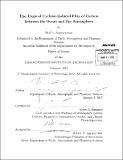| dc.contributor.advisor | Kerry A. Emanuel. | en_US |
| dc.contributor.author | Zimmerman, Neil L | en_US |
| dc.contributor.other | Massachusetts Institute of Technology. Dept. of Earth, Atmospheric, and Planetary Sciences. | en_US |
| dc.date.accessioned | 2012-05-15T21:12:02Z | |
| dc.date.available | 2012-05-15T21:12:02Z | |
| dc.date.copyright | 2012 | en_US |
| dc.date.issued | 2012 | en_US |
| dc.identifier.uri | http://hdl.handle.net/1721.1/70782 | |
| dc.description | Thesis (S.M.)--Massachusetts Institute of Technology, Dept. of Earth, Atmospheric, and Planetary Sciences, 2012. | en_US |
| dc.description | Cataloged from PDF version of thesis. | en_US |
| dc.description | Includes bibliographical references (p. 77-81). | en_US |
| dc.description.abstract | Tropical cyclones are known to cause phytoplankton blooms in regions of the ocean that would otherwise support very little life; it is also known that these storms entrain carbon-rich deep water, which can cause locally-significant air-sea fluxes. However, the relative magnitude of these two processes has mostly not been established, and questions about their global impact on the carbon cycle remain. A high-resolution model is developed, using established techniques and tabulated and published inputs, which tracks the physical, chemical, and biological evolution of the ocean's mixed layer in response to atmospheric forcing. Its ability to recreate the observed ocean state is tested. This model is used to simulate a real region of ocean, both with and without the mixing induced by a tropical cyclone, in order to find the change in biological activity and carbon content, and to track the evolution of this anomaly through the end of the winter. After carefully examining a few specific cases that have been discussed in previous literature, one calendar year's worth of storms are modeled, and their net effect is summarized. It is shown that many storms do enhance biological productivity, but only in a few rare cases does the amount of carbon sunk by phytoplankton decay exceed the amount mixed upward by the entrainment of cold, carbon-rich water. The sign of the storm-induced carbon flux is thus shown to be upward for nearly all storms. However, even this effect is small: the net efflux of carbon from the deep ocean to the mixed layer and the atmosphere in the year 2006 is found to be at most on the order of a few tens of teragrams. This is consistent with other studies. | en_US |
| dc.description.statementofresponsibility | by Neil L. Zimmerman. | en_US |
| dc.format.extent | 81 p. | en_US |
| dc.language.iso | eng | en_US |
| dc.publisher | Massachusetts Institute of Technology | en_US |
| dc.rights | M.I.T. theses are protected by
copyright. They may be viewed from this source for any purpose, but
reproduction or distribution in any format is prohibited without written
permission. See provided URL for inquiries about permission. | en_US |
| dc.rights.uri | http://dspace.mit.edu/handle/1721.1/7582 | en_US |
| dc.subject | Earth, Atmospheric, and Planetary Sciences. | en_US |
| dc.title | The tropical cyclone-induced flux of carbon between the ocean and the atmosphere | en_US |
| dc.type | Thesis | en_US |
| dc.description.degree | S.M. | en_US |
| dc.contributor.department | Massachusetts Institute of Technology. Department of Earth, Atmospheric, and Planetary Sciences | |
| dc.identifier.oclc | 792739706 | en_US |
